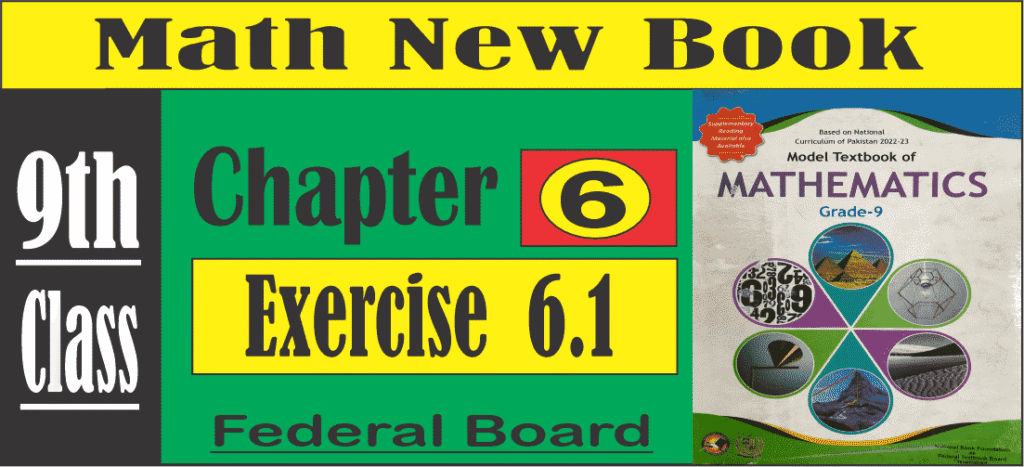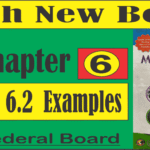Math 9th Exercise6.1 NBF
Math 9th Exercise6.1 NBF will be solved. Understanding the fundamentals of geometry is essential for mastering mathematics. One of the foundational topics in Class 9 Mathematics is Exercise 6.1, which focuses on lines, angles, and their properties. This exercise provides the basis for solving more advanced problems in geometry. In this blog post, we will explore the key concepts, definitions, and problem-solving techniques necessary for mastering Exercise 6.1.
Q1 Convert the following measure of angles in seconds.
(i) :- $$5^\circ=\;{(\;5\times60)}’=\;300’\;\\={(\;300\times\;60)}”=18000”$$
(ii) :- $$30’\;=\;(\;30\times\;60)”\;=\;1800”$$
(iii) :- $$10^\circ30’=(10\times60+30)’=630’=(630\times60)”=37800”$$
(iv) :- $$20^\circ\;20’\;20″=(\;20\times3600\;)”+\;(\;20\times60\;)”+20”$$
= 72000″+ 1200″ + 20″
= 73220″
=========================
Q2 Convert the following measure of angle in minutes.
(i) :- $$70^\circ\;=\;(75\times60)’=4500’\;$$
(ii) :- $$120^\circ=(\frac{120}{60})’=\;2’\;$$
(iii) :- $$50^\circ40’=\;(\;50\times60\;)’+40’=\;3000+40’=\;3040’\;$$
(iv) :- $$30^\circ\;30’\;30″\\(30\times60)’+30′(\frac{30}{60})’$$
= 1800′ + 30′ + 0.5
= 1830 . 5
=========================
Q3 Convert the following measure of angle in degree and write the answer correct to 4 decimal places.
(i) :- $$135’=(\frac{135}{60})’=2.25^\circ$$
(ii) :- $$150’=(\frac{150}{3600})^\circ=0.0417^\circ$$
(iii) :- $$60^\circ\;60’=\;60^\circ+\;(\frac{60}{60})^\circ\\=\;60^\circ+1^\circ\;=\;61^\circ\\$$
(iv) :- $$45^\circ45’45”=(45+\frac{45}{60}+\frac{45}{3600})^\circ\\=\;(45+0.75+0.0125)^\circ\\=\;45.7625^\circ$$
=========================
Q4 :- Write the following measure of angle in DMS
(i) :- $$60.125^\circ$$
$$60.125^\circ=60^\circ+(0.125\times60)’$$
$$=\;60^\circ\;7.5’$$
$$=60^\circ\;7’+(0.5\times60)”$$
$$=\;60^\circ\;\;7’\;30”$$
(ii) :- $$135\;.\;375”$$
$$=(\frac{135.375}{60})’\\=\;2.25625’$$
$$=2’\;(0.25625\times60)”$$
$$=2’\;15.3”$$
$$=0^\circ\;2’\;15”$$
(iii) :- $$60.\;85’$$
$$=(\frac{60.85}{60})^\circ$$
$$=1.0142^\circ$$
$$=1^\circ(0.0142\times60)’$$
$$=1^\circ\;\;0.852’$$
$$=1^\circ\;\;0’\;(0.852\;\times60)”$$
$$=1^\circ\;\;0’\;\;51.12”\\=\;1^\circ\;0’\;51”$
(iv) :- $$255.\;45^\circ$$
$$=255^\circ\;(0.45\times60)$$
$$=255^\circ\;27’$$
=========================
Q5 :- Write the following in radius. Write the answer in terms of Pi.
i):- $$45^\circ$$
$$1^\circ=\frac{\mathrm\pi}{180}\;rad$$
Multiplying both the sides by 45
$$45^\circ=45\;(\frac{\mathrm\pi}{180})\;rad\\=\frac{\mathrm\pi}4\;rad$$
ii):- $$150^\circ$$
$$1^\circ=\frac{\mathrm\pi}{180}\;rad$$
Multiplying both the sides by 150
$$150^\circ=150\;(\frac{\mathrm\pi}{180})\;rad\\=\frac{5\mathrm\pi}6\;rad$$
iii):- $$60^\circ30’$$
$$60^\circ30’=60^\circ+(\frac{30}{60})^\circ\\=\;60^\circ+0.5^\circ\\=\;60.5^\circ$$
$$1^\circ=\frac{\mathrm\pi}{180}\;rad$$
Multiplying both the sides by 60.5
$$60.5^\circ=60.5\;(\frac{\mathrm\pi}{180})\;rad$$
$$=\frac{605}{10}\;(\frac{\mathrm\pi}{180})\;rad\\=\frac{121\;\mathrm\pi}{360}$$
iv):- $$120^\circ$$
$$1^\circ=\frac{\mathrm\pi}{180}\;rad$$
Multiplying both the sides by 120
$$120^\circ=\;120\;\;(\frac{\mathrm\pi}{180})\;rad\\=\frac{2\mathrm\pi}3\;rad$$
=========================
Q6 Convert the following in radian. Use Pi = 3.1416
i):- $$270^\circ$$
$$1^\circ\;=\;0.0175\;rad$$
Multiplying both the sides by 270
$$270^\circ\;=\;270\;\times\;0.0175\;rad\\=\;4.725\;rad$$
ii):- $$60^\circ$$
$$1^\circ\;=\;0.0175\;rad$$
Multiplying both the sides by 60
$$60^\circ\;=\;60\;\times\;0.0175\;rad\\=\;1.05\;rad$$
iii):- $$180^\circ45’$$
$$180^\circ45’\;=\;(180+\frac{45}{60})^\circ\\=\;(180+0.75)^\circ\\=\;180.75^\circ$$
$$1^\circ\;=\;0.0175\;rad$$
Multiplying both the sides by 180.75
$$180.75^\circ\;=\;180.75\;\times\;0.0175\;rad\\=\;3.1632\;rad$$
iv):- $$75^\circ\;30’\;45”$$
$$75^\circ30’45”=(75+\frac{30}{60}+\frac{45}{3600})^\circ\\=(75+0.5+0.0125)^\circ\\=75.5125^\circ$$
$$1^\circ\;=\;0.0175\;rad$$
Multiplying both the sides by 75.5125
$$75.5125^\circ\;=\;75.5125\;\times\;0.0175\;rad\\=\;1.3214\;rad$$
====================
Q7 Convert the following radian measures of angles in DMS
i):- $$\frac{\mathrm\pi}4\\\mathrm\pi\;\mathrm{rad}\;=\;180^\circ\\1\;\mathrm{rad}\;=\;\frac{180^\circ}{\mathrm\pi}$$
$$Multiplying\;both\;the\\sides\;by\;\;\frac{\mathrm\pi}4$$
$$\frac{\mathrm\pi}4rad=\frac{\mathrm\pi}4(\frac{180^\circ}{\mathrm\pi})\\=45^\circ$$
ii):-$$\frac{5\mathrm\pi}6\\\mathrm\pi\;\mathrm{rad}\;=\;180^\circ\\1\;\mathrm{rad}\;=\;\frac{180^\circ}{\mathrm\pi}$$
$$Multiplying\;both\;the\\sides\;by\;\;\frac{5\mathrm\pi}6$$
$$\frac{5\mathrm\pi}6rad=\frac{5\mathrm\pi}6(\frac{180^\circ}{\mathrm\pi})\\=150^\circ$$
iii):-$$\frac{\mathrm\pi}{12}\\1\;\mathrm{rad}\;=\;\frac{180^\circ}{\mathrm\pi}$$
$$Multiplying\;both\;the\\sides\;by\;\;\frac{\mathrm\pi}{12}$$
$$\frac{\mathrm\pi}{12}rad=\frac{\mathrm\pi}{12}(\frac{180^\circ}{\mathrm\pi})\\=15^\circ$$
iv):-$$\frac{7\mathrm\pi}{40}\\1\;\mathrm{rad}\;=\;\frac{180^\circ}{\mathrm\pi}$$
$$Multiplying\;both\;the\\sides\;by\;\;\frac{7\mathrm\pi}{40}$$
$$\frac{7\mathrm\pi}4rad=\frac{7\mathrm\pi}4(\frac{180^\circ}{\mathrm\pi})\\\\=\;31.5^\circ\\\\=\;31^\circ\;(0.5\times60)’\\\\=\;31^\circ\;30’$$
v):-$$1\;rad\\1\;\mathrm{rad}\;=\;\frac{180^\circ}{\mathrm\pi}$$
$$=\;57.2956^\circ\\\\=\;57^\circ(0.2956\times60)’\\\\=\;57^\circ\;17.736’$$
$$=\;57^\circ\;17’\;(0.736\times60)”\\\\=\;57^\circ\;17\;’\;45”$$
vi):-$$301416\;rad\\1\;\mathrm{rad}\;=\;\frac{180^\circ}{\mathrm\pi}$$
$$1\;rad\;=\frac{180^\circ}{\mathrm\pi}\\\\Multiplying\;both\;the\\sides\;by\;3.1416$$
$$3.1416\;rad\;=\;3.1416\;(\;\frac{180^\circ}{\mathrm\pi})\\\\=\;3.1416\;(\;\frac{180^\circ}{3.1416})\\\\=\;180^\circ$$
vii):-$$12\;\mathrm\pi\\1\;\mathrm{rad}\;=\;\frac{180^\circ}{\mathrm\pi}$$
$$Multiplying\;both\;the\\sides\;by\;12\;\mathrm\pi$$
$$12\;rad\;=12\mathrm\pi\;(\frac{180^\circ}{\mathrm\pi})\\\\=\;2160^\circ$$
viii):-$$5\;rad\\1\;\mathrm{rad}\;=\;\frac{180^\circ}{\mathrm\pi}$$
Multiplying both the sides by 5
$$5\;rad\;=\;5\;(\;\frac{180^\circ}{\mathrm\pi})\\\\=5\;(\;57.2956)^\circ\\\\=286.478^\circ$$
$$=286^\circ(0.478\times60)’\\\\=286^\circ\;28.68’\\\\=\;286^\circ\;28’\;(0.68\;\times60)”\\\\=286^\circ\;28’\;41”$$
====================================================================================
Check! Some important links below




